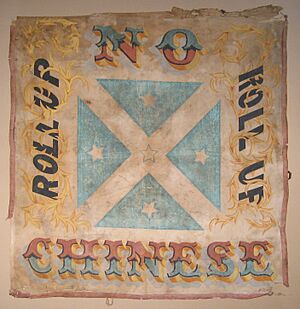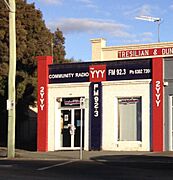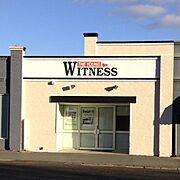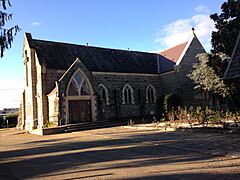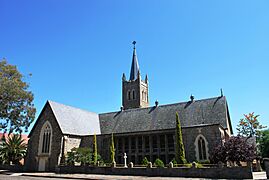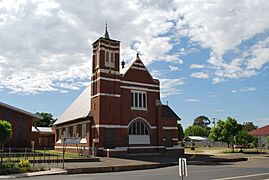Young, New South Wales facts for kids
Quick facts for kids YoungNew South Wales |
|||||||||
|---|---|---|---|---|---|---|---|---|---|
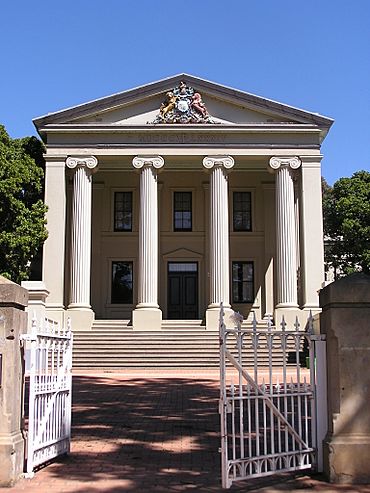
Young courthouse built in 1884 but transferred to the Department of Education in 1925 and used as the main hall of Young High School
|
|||||||||
| Established | 1826 | ||||||||
| Postcode(s) | 2594 | ||||||||
| Elevation | 440 m (1,444 ft) | ||||||||
| Location |
|
||||||||
| LGA(s) | Hilltops Council | ||||||||
| County | Monteagle | ||||||||
| State electorate(s) | Cootamundra | ||||||||
| Federal Division(s) | Riverina | ||||||||
|
|||||||||
Young is a town in the South Western Slopes region of New South Wales, Australia. It is the biggest town in the Hilltops Region. Young is often called the "Cherry Capital of Australia" because of its many cherry farms. Every year, the town hosts the National Cherry Festival. Young is located on the Olympic Highway, about two hours' drive from Canberra. The town is in a valley, surrounded by hills. It was named after Sir John Young, who was the governor of New South Wales from 1861 to 1867.
Contents
History of Young
Before European settlers arrived, the land around Young was home to the Burrowmunditory tribe. They are a family group of the Wiradjuri people. Today, descendants of this clan still live in Young.
In 1826, James White was the first European settler in the area. He started a large sheep farm called Burrangong Station. Gold was discovered in the area in 1860. Before this, the region was known as Lambing Flat, named after the sheep grazing that was the main activity. The town officially became Young in 1861. The goldfields produced a lot of gold, and up to 20,000 miners worked there. This included about 2,000 Chinese miners.
From late 1860 to mid-1861, there were conflicts between European and Chinese gold miners. These events are known as the Lambing Flat riots. As gold became harder to find, some European miners felt that the Chinese miners were more successful. This led to attacks, robberies, and violence against Chinese miners. Groups of up to 3,000 anti-Chinese rebels gathered. Eventually, the government brought in control. Chinese miners got their claims back. However, the New South Wales Parliament passed a law called the Chinese Immigration Bill. This law limited how many Chinese people could enter New South Wales on a ship. It also added a tax for each person entering.
In 1889, Young was the first town in Australia to have electricity in its streets and homes. Tamworth, another town, had only street lights the year before. The former Young Shire was also the first local government area to start a school bus system for rural students in New South Wales.
Historic Places in Young
Young has several places that are important for their history. These are called heritage-listed sites. They include:
- The Young railway station on the Blayney–Harden railway line.
- The City Bank building on Lynch Street.
- Blackguard Gully on Whiteman Avenue.
Young's Climate
Young has a humid subtropical climate. This means it has hot, humid summers and mild winters.
| Climate data for Young Airport | |||||||||||||
|---|---|---|---|---|---|---|---|---|---|---|---|---|---|
| Month | Jan | Feb | Mar | Apr | May | Jun | Jul | Aug | Sep | Oct | Nov | Dec | Year |
| Record high °C (°F) | 42.6 (108.7) |
42.0 (107.6) |
38.6 (101.5) |
32.6 (90.7) |
25.4 (77.7) |
21.9 (71.4) |
19.9 (67.8) |
23.6 (74.5) |
26.9 (80.4) |
34.4 (93.9) |
42.1 (107.8) |
41.1 (106.0) |
42.6 (108.7) |
| Mean daily maximum °C (°F) | 31.7 (89.1) |
30.4 (86.7) |
27.2 (81.0) |
22.7 (72.9) |
17.8 (64.0) |
13.9 (57.0) |
12.9 (55.2) |
14.6 (58.3) |
17.8 (64.0) |
21.9 (71.4) |
26.1 (79.0) |
29.1 (84.4) |
22.2 (72.0) |
| Mean daily minimum °C (°F) | 14.6 (58.3) |
14.7 (58.5) |
11.1 (52.0) |
6.6 (43.9) |
3.3 (37.9) |
2.4 (36.3) |
1.1 (34.0) |
1.3 (34.3) |
3.1 (37.6) |
5.3 (41.5) |
9.3 (48.7) |
11.8 (53.2) |
7.0 (44.6) |
| Record low °C (°F) | 1.4 (34.5) |
2.3 (36.1) |
0.4 (32.7) |
−4.1 (24.6) |
−5.8 (21.6) |
−6.1 (21.0) |
−6.4 (20.5) |
−6.5 (20.3) |
−5.5 (22.1) |
−4.7 (23.5) |
−2.4 (27.7) |
−0.2 (31.6) |
−6.5 (20.3) |
| Average precipitation mm (inches) | 41.0 (1.61) |
51.4 (2.02) |
46.2 (1.82) |
31.5 (1.24) |
40.0 (1.57) |
64.1 (2.52) |
60.9 (2.40) |
51.0 (2.01) |
54.4 (2.14) |
45.9 (1.81) |
64.0 (2.52) |
57.8 (2.28) |
589.7 (23.22) |
| Average precipitation days | 6.7 | 7.3 | 6.9 | 5.7 | 9.6 | 14.9 | 17.5 | 14.7 | 11.6 | 9.1 | 8.5 | 7.1 | 119.6 |
Population of Young
In 2021, the population of Young was 10,610 people. This was an increase from 10,295 people in 2016.
In 2016, about 5.1% of the people in Young identified as being of Indigenous origin. The average age of people living there was 40 years old. Many people in Young were born in Australia. The most common backgrounds people identified with were Australian, English, and Irish. English was the main language spoken at home by most people.
| Historical population | ||
|---|---|---|
| Year | Pop. | ±% |
| 1921 | 3,283 | — |
| 1933 | 4,011 | +22.2% |
| 1947 | 4,656 | +16.1% |
| 1954 | 5,503 | +18.2% |
| 1961 | 5,448 | −1.0% |
| 1966 | 5,754 | +5.6% |
| 1971 | 6,064 | +5.4% |
| 1976 | 6,459 | +6.5% |
| 1981 | 6,906 | +6.9% |
| 1986 | 6,797 | −1.6% |
| 1991 | 6,666 | −1.9% |
| 1996 | 6,798 | +2.0% |
| 2001 | 6,821 | +0.3% |
| 2006 | 7,141 | +4.7% |
| 2011 | 6,960 | −2.5% |
| 2016 | 7,170 | +3.0% |
| 2021 | 7,712 | +7.6% |
| Source: Australian Bureau of Statistics data. | ||
The Lambing Flat Chinese Tribute Gardens
The Young Shire Council created the Lambing Flat Chinese Tribute Gardens. They are next to Chinamans Dam, an old dam about 4 kilometers south of Young. The gardens are designed to feel peaceful, like the Japanese Gardens in Cowra.
Chinamans Dam was built in the 1860s by two German brothers, Herman and John Tiedemann. They used the water to help them find gold. Later, in the 1870s, a Chinese group bought the area and continued to work the site.
The dam was used by the railway starting in 1882. It provided water for steam trains. From 1885 to 1901, trains would stop at "Young Tank" to get water. In 1901, new watering places were built at Young Station, still getting water from Chinamans Dam. The dam was made bigger in 1911. It was also a popular place for swimming, even though it wasn't officially allowed.
After 1936, the railways stopped using Chinamans Dam. This was because water from Burrinjuck Dam became available. In 1962, the land was returned to the government. The next year, a reserve was created, and the Shire Council became its managers. The dam has been made even larger since then.
Schools in Young
Young has six schools for students:
- St Mary's Primary School
- New Madinah College
- Young North Primary School
- Young Public School
- Hennessy Catholic College
- Young High School
Sports in Young
Rugby football is very popular in Young. The town had a strong Maher Cup rugby league team for many years.
Here are some of the sports teams in Young:
- The Young Cherrypickers are a rugby league team. They play in the Group 9 competition.
- The Burrangong Bears are another rugby league team. They play in the George Tooke Shield competition.
- The Young Yabbies are a rugby union team. They play in the Southern Inland Rugby Union competition.
- The Young Lions are a soccer club. They have teams for both senior men and women.
Australian rules football was also popular at times. The Young Saints had success in the Central West AFL in the 1980s. However, the junior club closed in 2018.
Media in Young
Young has several ways for people to get news and entertainment.
Newspapers
- Burrangong Argus (1864–1914)
- Burrangong Chronicle (1873–1902)
- Burrangong Courier (1962)
- The Lambing Flat Miner (1862–1961)
- Young Chronicle (1902–1947)
- The Young Witness (1909–present)
Radio Stations
- ABC Classic FM 88.3
- ABC Radio National 89.1/97.1
- ABC Riverina 89.9/96.3
- Roccy FM 93.9 (commercial radio)
- SBS Radio FM 98.7 (retransmission)
- triple j 90.7
- 2LF AM 1350 (commercial radio)
- 2YYY (community radio)
Churches in Young
Young has several churches and places of worship:
- Kingdom Hall of Jehovah's Witnesses, Wombat Street
- New Life Community Church – McDonnels Road
- St John's Anglican Church – cnr Cloete and Zouch Streets
- St Mary's Roman Catholic Church – Ripon Street
- St Paul's Presbyterian Church – cnr Lynch and Lovell Streets
- Young Baptist Church – Nasmyth Street
- Young Mosque (Lebanese Muslim Association) – Moppity Road
- Young Seventh-Day Adventist Church – Wombat Street
- Young Uniting Church – cnr Lynch and Cloete Streets
Famous People from Young
Many notable people have connections to Young, including:
- Charles Anderson (1897–1988), a Member of Parliament and war hero.
- Dorothy M. Catts (1877–1961), a writer and businesswoman.
- Donald Chalmers, who was the Chief of the Australian Navy from 1997 to 1999.
- Thomas Collins (1884–1945), a Member of Parliament.
- Rose Ann Creal, a matron who received a special award for her nursing.
- Peter Cusack, a rugby league player.
- Libby Gleeson, a well-known children's author.
- Bert Hopkins, an Australian cricketer.
- Ron Lynch, a rugby league player and coach.
- Nathan Lyon, an Australian cricketer.
- Frances MacKeith, a British peace advocate.
- Roger McDonald, an author.
- Brendon Reeves, a rugby league player.
- Kerry Saxby-Junna, a racewalker who won two Commonwealth Games gold medals.
- Brett Mullins, a rugby league player.
- James Schiller, a rugby league player.
- Isaac Smith, an AFL footballer.



